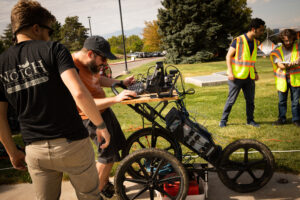 Researchers from the University of Vermont visited Utah recently to utilize the University of Utah’s POWDER wireless communications testbed for experiments involving a new tool that helps contractors detect objects underground.
Researchers from the University of Vermont visited Utah recently to utilize the University of Utah’s POWDER wireless communications testbed for experiments involving a new tool that helps contractors detect objects underground.
This new ground-penetrating radar system, being developed by University of Vermont mechanical engineering professor Dryver Huston and his team, is capable of looking underground about six to seven feet to detect obstacles such as electric lines, natural gas lines or water tanks. This device can help contractors locate underground utilities while digging during construction.
Huston is using the U’s POWDER (Platform for Open Wireless Data-driven Experimental Research) to test the device’s ability to transmit large amounts of underground and computational data from the machine to a computer as well as to a remote data center. The machine uses advanced artificial intelligence as well as augmented reality (AR) goggles to visualize for the user where utilities may be underground.
With AI and AR, the amount of information that flows is pretty high,” Huston said. “POWDER has the high-speed networking that we can use to talk to the computer so the computer can do the heavy-duty analysis.”
More than three years ago, the University of Utah and Rice University launched one of the world’s largest testbeds for advanced wireless communications research. POWDER and Rice’s Reconfigurable Ecosystem for Next-gen End-to-end Wireless (RENEW) have created an outdoor laboratory that covers an area of approximately four-square kilometers on and around the University of Utah campus, creating a go-to testbed for current and future wireless technologies such as 5G and 6G.
This dynamic and powerful lab uses custom software on general-purpose hardware, known as software-defined radios, to establish how a communication network functions. Depending on a researcher’s requirements, the testbed configuration could mimic any kind of cellular or wireless network and even use spectrum that is currently not available commercially.
Since the outdoor lab launched in 2018, more than 700 users have conducted over 14,300 experiments involving more than 175 separate projects, said University of Utah School of Computing professor Kobus Van der Merwe, who is leading the POWDER platform. These projects are not only with leaders in the telecommunications industry but also with the world’s top research institutions.
Van der Merwe said the University of Vermont project is just one example of the kinds of diverse experiments that can be conducted on the POWDER testbed. “It proves the flexibility of POWDER, that it can be used in these other ways,” he said.
POWDER is one of four similar testbeds created in the U.S. for The Platforms for Advanced Wireless Research (PAWR) program, a $100-million joint effort by the National Science Foundation and an industry consortium of wireless and other tech companies.
“There’s four testbeds across the country, and this is by far the best one for what we want to try,” Huston said.